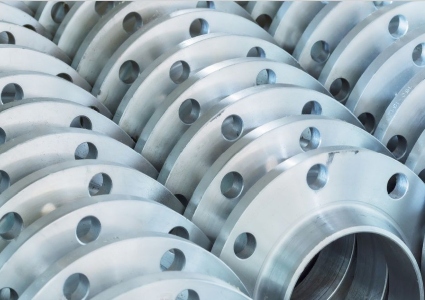
what is a plate flange?
The plate flange consists of a flat plate with a hole in the center. It is typically used to connect two pipes, but is also frequently used to connect other objects such as valves, fittings, and pumps. The plate flange is typically made of carbon steel, but can be made from any material, depending on the application. It is usually welded to the pipe, but can also be bolted or screwed depending on the application and preference.
The strength of the plate flange is determined by its size, material, and manufacturing process. For example, larger plate flanges are generally stronger than smaller ones, and those made of higher-quality materials are generally stronger than those made of lower-quality materials. The strength of the connection is also determined by the method of installation. Bolted and screwed connections are generally considered to be stronger than welded connections, though welded connections are also used.
The plate flange is a type of flange that is easy to install, cost-effective, and strong. It is typically made from carbon steel, but can be made from any material, depending on the application. It can be welded, bolted, or screwed to the pipe, and is used in many different industries. It is an essential component for many piping systems, as it provides a secure and reliable connection.
Plate flanges material
Plate flanges come in a variety of different materials, including carbon steel, stainless steel, and aluminum. Each material has its own advantages and disadvantages, so it is important to select the right material based on the specific application. Carbon steel flanges are the most common type of plate flanges, as they are economical, durable, and easy to work with. Stainless steel flanges offer superior corrosion resistance, while aluminum flanges are lightweight and offer superior heat resistance.
plate flange dimensions
Typically, a plate flange is a flat, circular disk that is welded onto the end of a pipe. The outside diameter of this disk is usually the same as the outside diameter of the pipe, and the flange typically has a raised face, with the exception of lap joint flanges, which do not have a raised face. The raised face may include small grooves, or “rings,” that are designed to accommodate a gasket and to provide a leak–proof seal. The flange typically has holes drilled in it to accommodate bolts, which are used to hold the flange in place. The size of the holes, as well as the size of the flange, will vary depending on the size of the pipe and the type of material used for the flange.
plate flange standard
The standards for plate flange vary depending on the specific application. The most widely accepted standard is the American National Standard Institute (ANSI) B16.5, which is an international standard used by many industries. This standard covers the materials, dimensions, tolerances, pressure ratings, and other requirements for plate flanges. Additionally, ASME B16.47 is a standard used in the United States, which is similar to the ANSI standard. In addition to the standards set by ANSI and ASME, plate flange standards are also determined by the specific application. Different types of pipe and connections will require different types of plate flanges. For example, the type of pipe and connection used in a water system will be different than the type used in an oil and gas system. The size of the pipe, the pressure rating, and the type of connection will all be factors when choosing the right type of plate flange. When ordering plate flange standards, it is important to ensure that the right size and type of flange is ordered. The size of the flange should match the size of the pipe that it is joining, and the type should match the connection type. Additionally, the pressure rating should match the pressure rating of the pipe that it is joining. Finally, it is important to make sure that the flange meets the standards set by the appropriate organization, such as ANSI or ASME.
If you want to learn more details about plate flange dimensions according to ANIS B16.5, kindly click below the link to read more
https://www.znsteelflange.com/product-category/ansi-b16-5-flange/
In which countries are plate flanges most popular?
Plate flanges are most popular in the United States, Canada, United Kingdom, Germany, France, China, India, and Japan.





